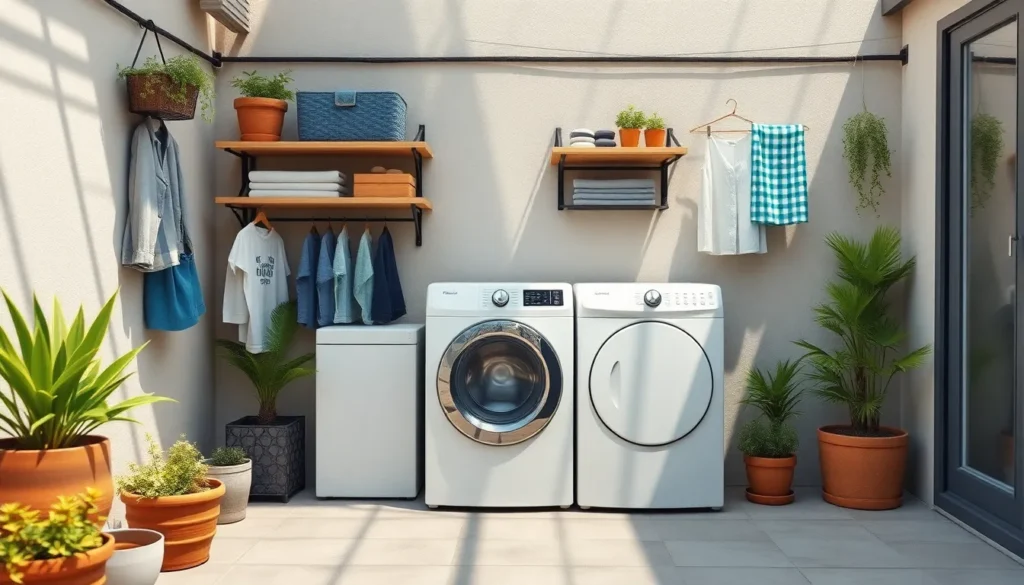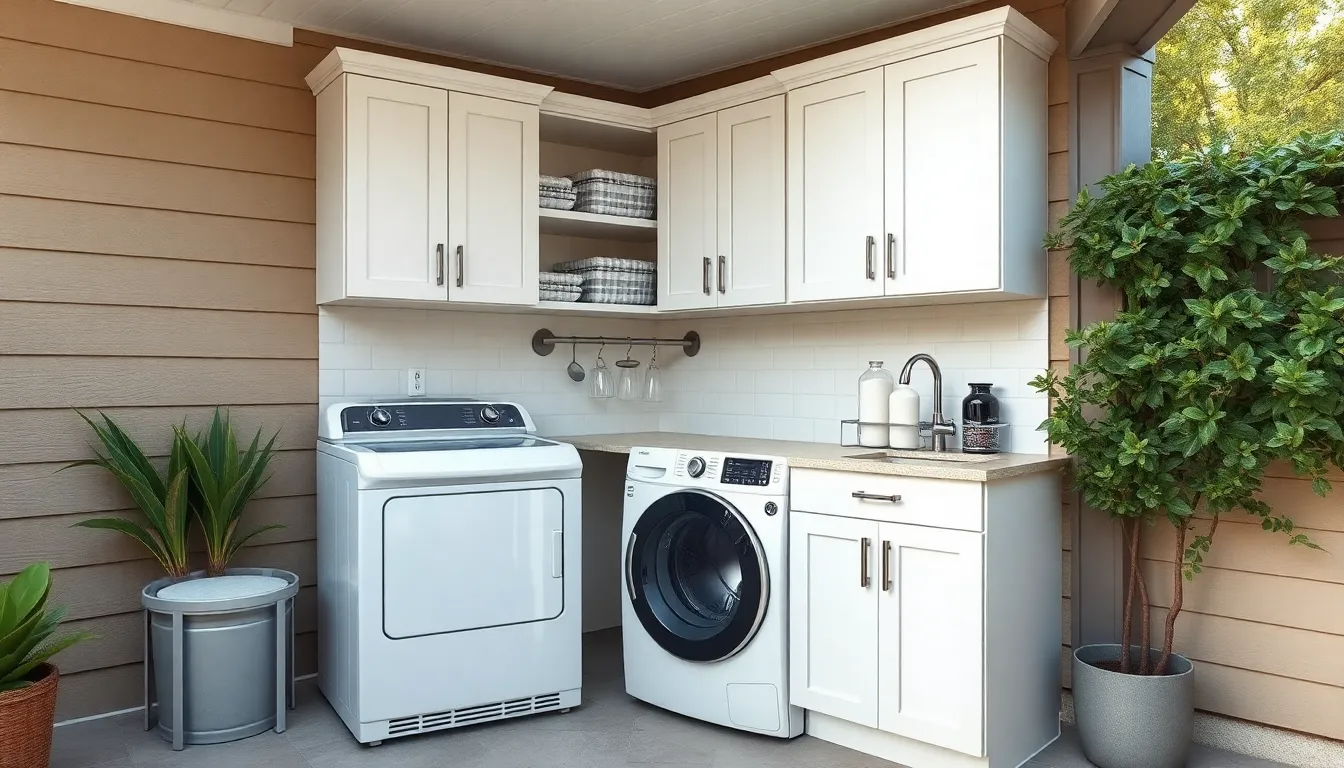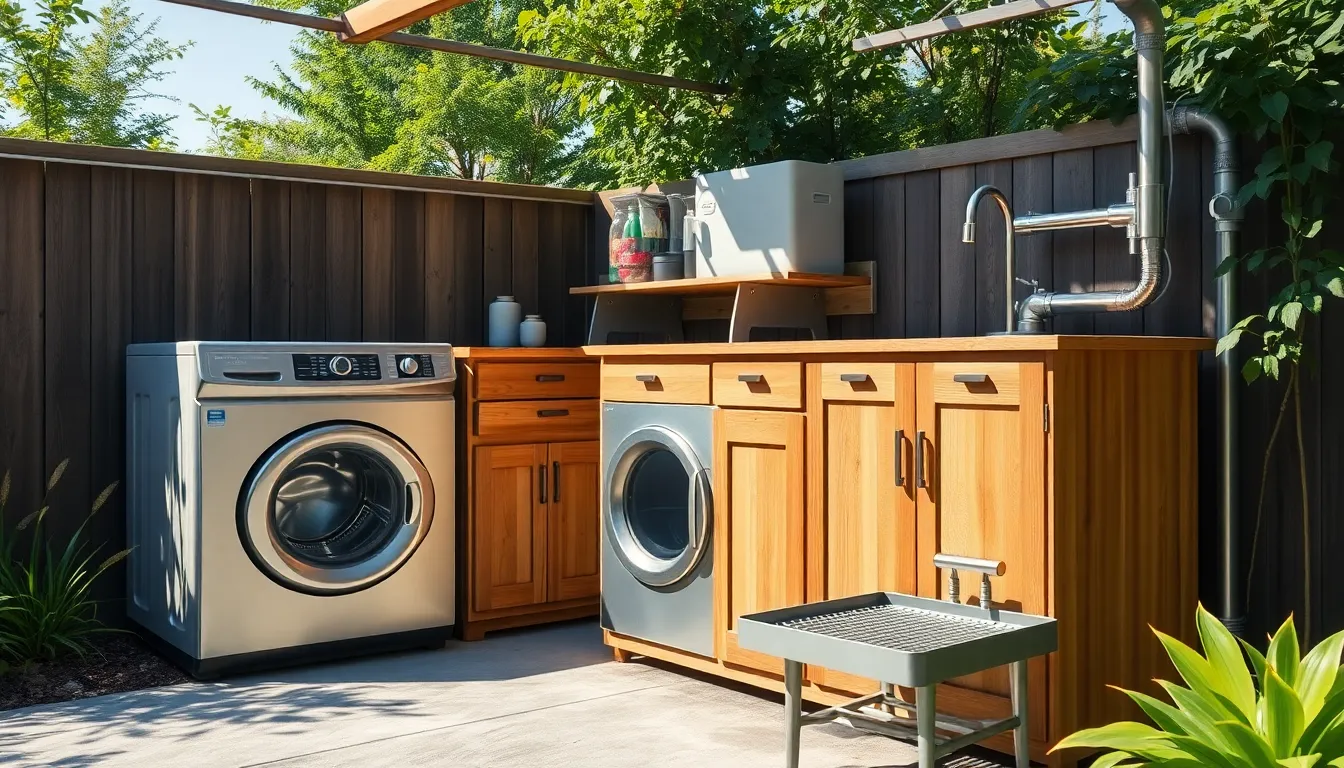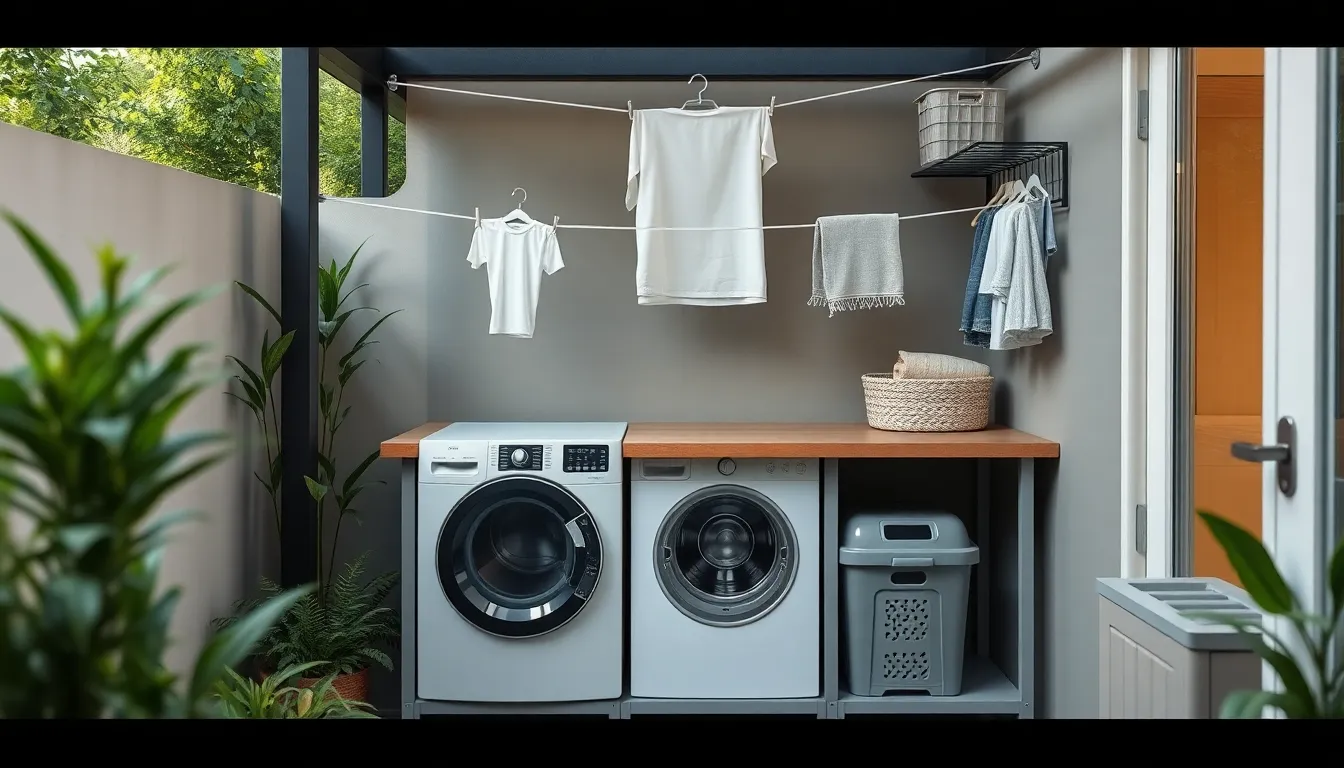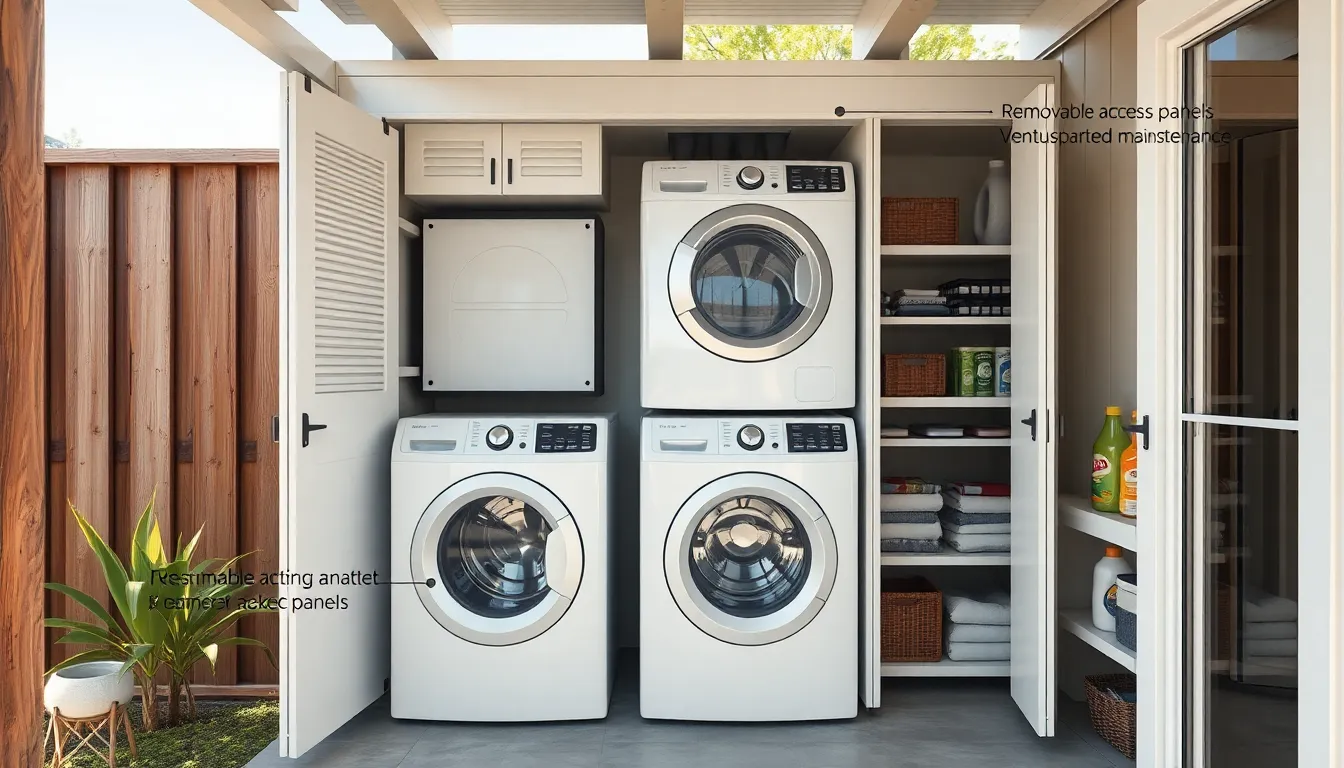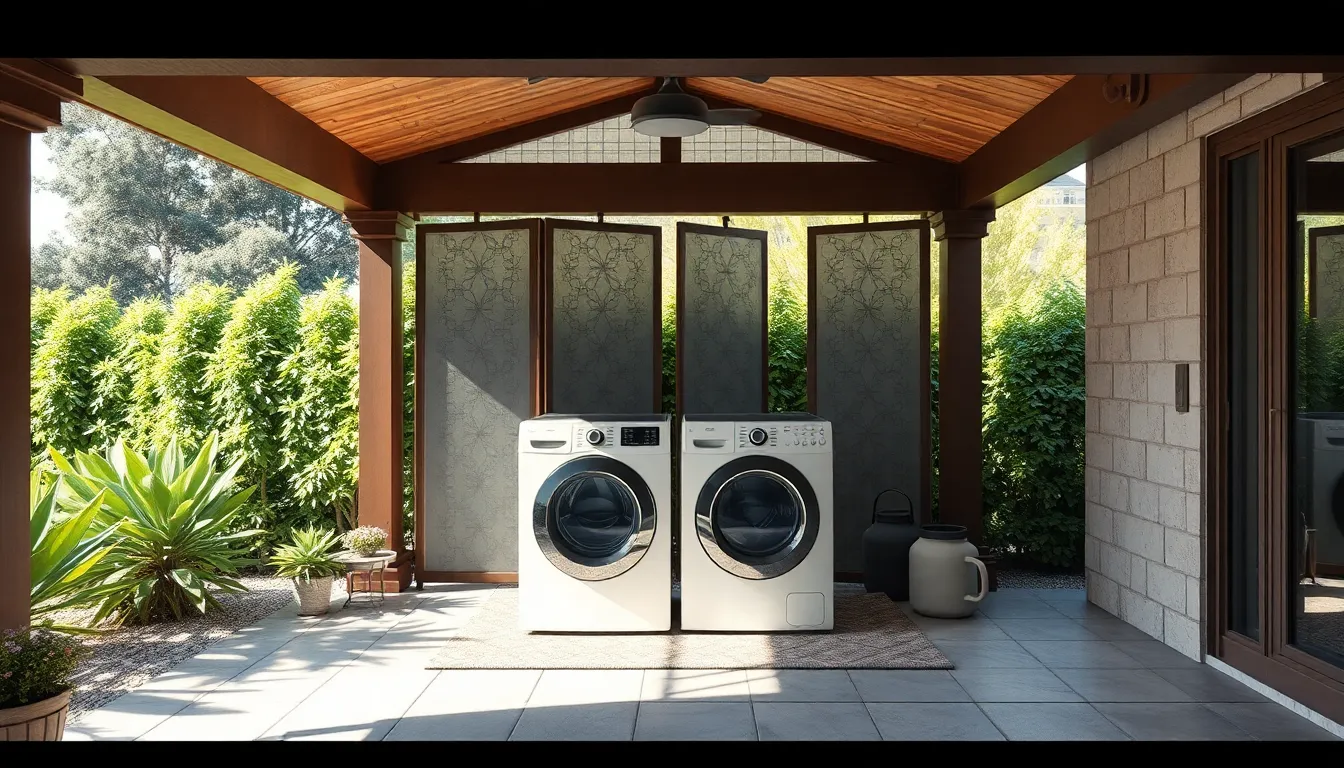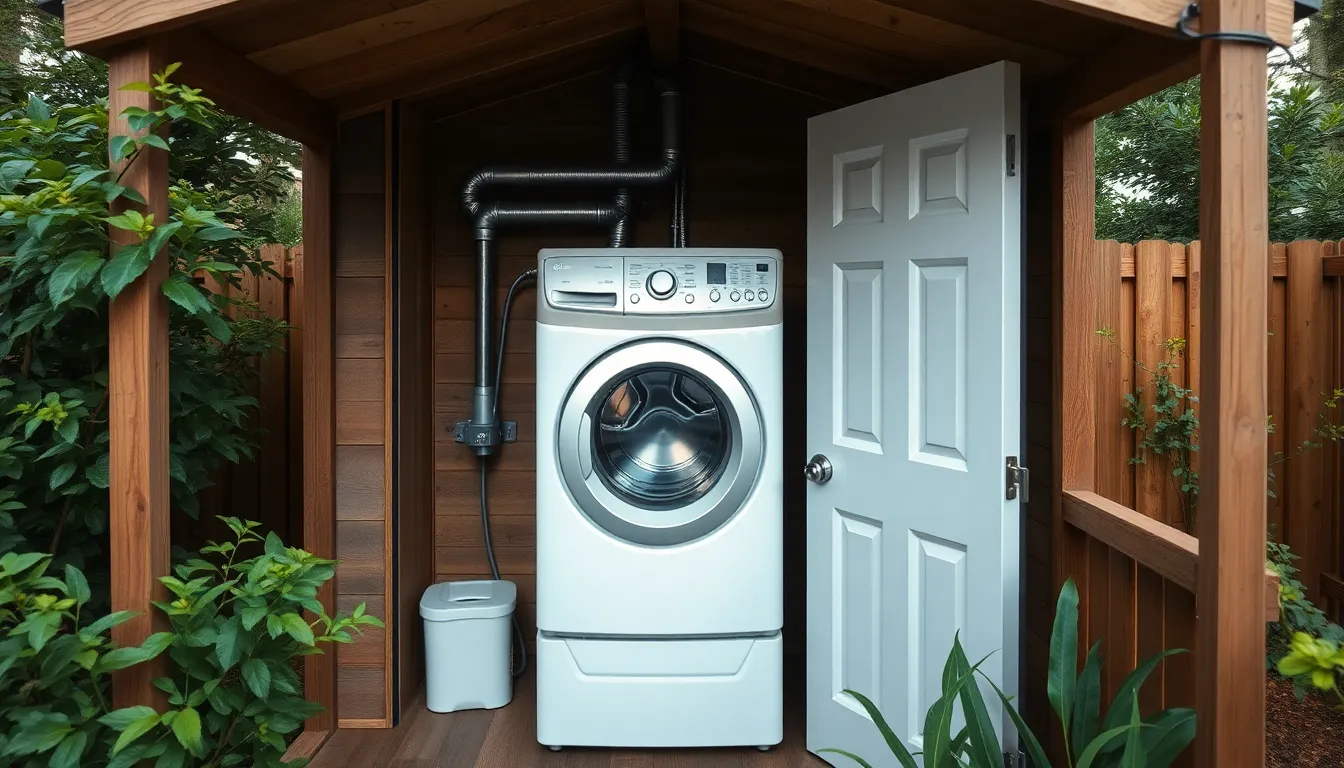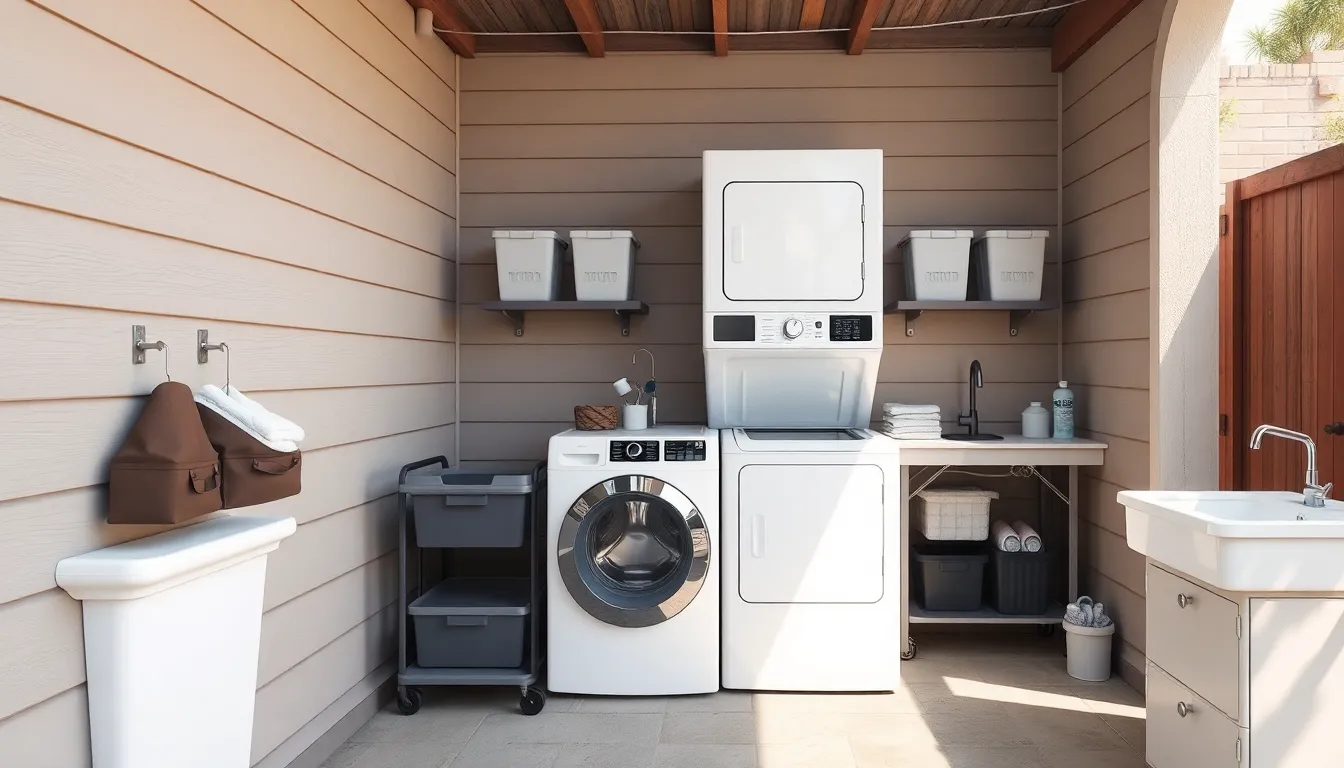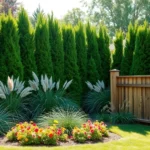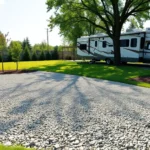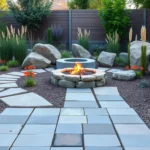We’ve all been there – staring at our cramped indoor spaces and wondering where on earth we’ll fit a functional laundry area. The truth is, outdoor laundry rooms aren’t just practical answers for small homes – they’re game-changers that can transform how we think about maximizing our living space.
Creating an outdoor laundry space doesn’t require a massive budget or extensive construction. With clever planning and creative design choices, we can turn even the tiniest corner of our patio, balcony, or backyard into a fully functional washing station. From weatherproof storage answers to compact washer-dryer combinations, there are countless ways to make outdoor laundry work for small spaces.
Whether you’re dealing with a studio apartment, a tiny house, or simply want to free up precious indoor square footage, outdoor laundry rooms offer flexibility and efficiency that traditional setups can’t match. We’ll show you how to create a space that’s both practical and stylish while keeping your budget in check.
Maximize Vertical Space With Wall-Mounted Solutions
Wall mounted answers transform cramped outdoor laundry areas into efficient workspaces by utilizing every inch of available height.
Install Floating Shelves Above Washer and Dryer
Floating shelves create essential storage space directly above your appliances without blocking access to controls or lids. We recommend installing 2-3 shelves at 12-inch intervals to accommodate various container sizes like detergent bottles, fabric softener, and stain removers.
Weatherproof materials like marine-grade plywood or powder-coated metal brackets ensure your shelving withstands outdoor elements. Choose shelves that extend 8-10 inches from the wall to prevent items from falling behind your machines during operation.
Position the bottom shelf at least 18 inches above your washer to allow comfortable loading and unloading. This height also prevents accidental spills from reaching your appliances during routine maintenance tasks.
Add Wall-Mounted Drying Racks
Wall mounted drying racks maximize drying capacity while consuming minimal floor space in compact outdoor areas. Accordion style racks extend up to 36 inches when needed and fold flat against the wall when not in use.
Install multiple racks at different heights to accommodate various garment lengths from shirts to pants. We suggest mounting the first rack 48 inches from the ground and the second at 72 inches for optimal accessibility and air circulation.
Stainless steel construction resists rust and corrosion from outdoor moisture exposure. Some models feature 6-8 drying bars that can handle up to 40 pounds of wet laundry while maintaining structural integrity.
Use Pegboard Systems for Storage
Pegboard systems offer customizable storage answers that adapt to your changing outdoor laundry needs throughout different seasons. Standard 4×8 foot panels provide dozens of hook placement options for tools, brushes, and cleaning supplies.
Metal pegboards outperform wooden versions in outdoor environments by resisting warping and moisture damage. We recommend panels with 1/4-inch holes spaced at 1-inch intervals for maximum hook compatibility and weight distribution.
Specialized pegboard accessories like small bins, tool holders, and utility hooks keep frequently used items like clothespins, measuring cups, and lint brushes within easy reach. This organization system reduces time spent searching for supplies during laundry tasks.
Create Multi-Functional Storage With Compact Cabinets
Smart storage answers transform cramped outdoor laundry spaces into organized workstations. We recommend compact cabinets that serve multiple purposes by housing laundry supplies, cleaning tools, and outdoor essentials in a single unit.
Choose Slim Profile Upper Cabinets
Slim profile upper cabinets maximize storage without overwhelming your small outdoor laundry area. These space saving units take up minimal visual and physical space while providing valuable storage for detergents, fabric softeners, and stain removers. We suggest installing weatherproof cabinets with depths between 8 to 12 inches to maintain easy access without crowding the workspace. White or light colored finishes reflect heat and create an illusion of more space in confined outdoor areas.
Install Pull-Out Drawers Under Appliances
Pull-out drawers beneath washers and dryers use previously wasted space for essential storage needs. These sliding compartments accommodate smaller items like laundry pods, clothespins, dryer sheets, and cleaning rags while keeping them protected from outdoor elements. We recommend installing drawer slides rated for outdoor use to prevent rust and ensure smooth operation. Full extension slides allow complete access to stored items without having to reach into dark corners.
Add Corner Storage Units
Corner storage units capture unused space that often goes overlooked in small outdoor laundry rooms. These specially designed units fit into tight nooks and provide surprisingly large storage capacity without impeding movement around appliances. We suggest triangular or curved corner cabinets that accommodate tall bottles of detergent and bulk supplies. Installing corner units at varying heights creates a custom storage system that maximizes every available inch of your outdoor laundry space.
Design Weather-Resistant Outdoor Laundry Stations
Building a weatherproof outdoor laundry area requires strategic planning to protect your investment from the elements. We’ll focus on creating durable spaces that can handle rain, wind, and sun exposure while maintaining functionality.
Select Waterproof Materials and Finishes
Treated wood forms the foundation of weather-resistant outdoor laundry cabinetry because it naturally repels moisture and insects. Metal fixtures with rust-resistant coatings provide long-lasting hardware answers that won’t deteriorate under constant exposure to humidity and rain. Weatherproof composites offer another excellent option for countertops and shelving since they resist warping and cracking in temperature fluctuations.
Flooring materials require special attention in outdoor laundry spaces. Concrete surfaces create durable foundations that handle heavy appliances while providing easy cleanup after spills. Outdoor-rated tiles designed specifically for exterior use offer both functionality and aesthetic appeal without compromising on water resistance.
Cabinet finishes need marine-grade sealers to prevent moisture penetration and wood rot. Stainless steel components resist corrosion better than standard metals in high-humidity environments. Powder-coated surfaces maintain their appearance longer when exposed to outdoor elements compared to traditional paint finishes.
Install Proper Drainage Systems
Floor drains prevent water accumulation around washing machines and protect your outdoor laundry foundation from damage. We recommend positioning drains at the lowest point of your laundry area to ensure complete water removal during heavy rain or appliance overflows.
Sloped surfaces direct water away from appliances and electrical components automatically. Creating a gentle slope of 1/4 inch per foot helps rainwater flow toward designated drainage areas without creating walking hazards. French drains around the perimeter capture runoff before it reaches your laundry equipment.
Gutters and downspouts channel roof water away from your outdoor laundry station. Installing adequate overhead drainage prevents water from pooling near electrical outlets and appliance connections. Splash blocks or drainage pipes extend water flow at least 6 feet from your laundry area to avoid moisture-related problems.
Choose UV-Resistant Storage Answers
Storage cabinets need UV-resistant materials to prevent fading and warping under constant sun exposure. Resin-based cabinets maintain their structural integrity better than standard wood when exposed to direct sunlight for extended periods. Aluminum storage units offer excellent UV protection while providing lightweight yet durable organization answers.
Vertical storage maximizes space efficiency in small outdoor laundry areas without sacrificing weather resistance. Wall-mounted cabinets with UV-resistant finishes keep detergents and supplies organized while protecting them from rain and sun damage. Stackable storage containers made from UV-stabilized plastics provide flexible organization options that adapt to your changing needs.
Shelving systems require materials that won’t become brittle or discolored after years of sun exposure. Powder-coated metal shelves resist both UV damage and moisture better than painted surfaces. High-density polyethylene shelving maintains its strength and color even after prolonged outdoor use while supporting heavy laundry supplies.
Incorporate Folding and Collapsible Features
Smart space management becomes essential when working with compact outdoor laundry areas. Folding and collapsible features maximize functionality while keeping our outdoor washing stations clutter free.
Install Fold-Down Countertops
Fold-down countertops mounted on walls provide instant workspace without permanently occupying precious square footage. We can create a DIY fold-down folding table above the washer and dryer for sorting clothes, pretreating stains, and organizing laundry supplies. These wall-mounted surfaces fold flat against the wall when not needed, instantly opening up the area for movement and other activities.
Mounting these countertops at the right height ensures comfortable use while maintaining easy access to appliances below. Weather-resistant materials like treated wood or composite materials work best for outdoor installations, providing durability against moisture and temperature changes.
Use Retractable Clotheslines
Retractable clotheslines offer superior space efficiency compared to traditional fixed lines in small outdoor laundry rooms. These systems pull out when we need drying space and retract to a compact size when laundry tasks are complete. Installation typically requires mounting one end to a wall or post, with the line extending to another anchor point across the space.
Multiple retractable lines can be installed at different heights to accommodate various clothing types, towels, and linens. The compact design makes them perfect for patios, balconies, or small yard areas where permanent clotheslines would overwhelm the space.
Add Collapsible Laundry Baskets
Collapsible laundry baskets reduce clutter and store efficiently in tight outdoor laundry spaces. These baskets expand during use to hold substantial loads of clothing, then fold down to fit into narrow storage gaps between appliances or inside cabinets. We can keep multiple baskets for sorting lights, darks, and delicates without sacrificing storage space when they’re not in use.
Selecting weather-resistant collapsible baskets ensures they withstand outdoor conditions while maintaining their shape and functionality. Some models feature reinforced handles and ventilated sides that promote airflow, making them ideal for outdoor washing routines.
Utilize Stackable Appliances for Space Efficiency
Stackable washers and dryers revolutionize compact outdoor laundry spaces by maximizing vertical room utilization. We can free up valuable floor space for storage answers or workspace areas by consolidating our laundry functions into a vertical configuration.
Choose Compact Washer-Dryer Combos
All in one washer-dryer combo units eliminate the need for two separate machines while delivering complete laundry functionality. These space saving appliances excel in tight outdoor utility areas or shed style laundry rooms where every square foot matters. We recommend selecting models specifically designed for outdoor environments that can handle varying temperature conditions.
Combination units typically measure 24 to 27 inches wide compared to traditional side by side configurations that require 48 to 54 inches of width. This dramatic space reduction allows us to incorporate additional storage or workspace features into our outdoor laundry design.
Install Proper Ventilation for Stacked Units
Adequate airflow prevents moisture buildup and overheating issues that can damage both appliances and surrounding structures. We must incorporate exhaust vents or louvered doors into our outdoor enclosures to maintain optimal operating conditions. Strategic ventilation placement protects machines from direct weather exposure while ensuring sufficient air circulation.
Outdoor stackable units require weather protected housing within cabinetry or specialized enclosures that balance protection with ventilation needs. Installing intake vents near the bottom and exhaust points at the top creates natural airflow patterns that extend appliance lifespan significantly.
Create Access Panels for Maintenance
Removable panels or hinged doors provide essential service access without requiring complete enclosure dismantling during repairs. We can incorporate these maintenance features into our outdoor cabinetry design to ensure quick troubleshooting and part replacement when needed.
Access panels should accommodate both front loading mechanisms and rear connection points for utilities like water, drainage, and electrical connections. Strategic panel placement saves time during routine maintenance while preventing unnecessary wear on our outdoor laundry structure components.
Build Custom Outdoor Laundry Closets
Custom enclosures offer the perfect solution when we need to maximize every square inch of our outdoor laundry space. We can design these closets to fit precisely into available areas, whether that’s a narrow side yard or compact patio corner.
Design Weatherproof Enclosures
Weatherproofing protects our laundry appliances from rain, wind, and sun exposure while maintaining optimal functionality. We recommend using waterproof siding materials like treated wood or metal to create tight enclosures that shield machines from harsh elements. Roof overhangs and pergolas provide additional shelter, creating a protective barrier that allows proper ventilation while preventing moisture buildup.
Materials matter significantly when building outdoor laundry enclosures. We suggest selecting treated lumber for framing, which resists rot and insect damage over time. Metal roofing panels offer excellent water protection and reflect heat effectively. Waterproof sealants around joints and seams ensure our enclosure remains completely weathertight.
Proper ventilation prevents condensation issues that can damage appliances and create mold problems. We install louvered vents near the top and bottom of enclosures to promote air circulation. Strategic placement of these vents allows hot air to escape while preventing rain from entering our laundry space.
Add Lockable Doors for Security
Lockable doors provide essential security for expensive laundry appliances while containing operational noise. We recommend installing heavy duty hinges and quality deadbolt locks to deter theft and tampering. These doors also help maintain a clean outdoor appearance by concealing appliances when not in use.
Door materials should match our weatherproofing strategy for consistent protection. We prefer composite or treated wood doors with weatherstripping to create tight seals. Metal security doors offer maximum protection but require proper rust prevention treatments in humid climates.
Bifold doors work exceptionally well in tight spaces where swing clearance is limited. We can install these space saving options to provide full access to appliances while requiring minimal operating room. Sliding barn door hardware creates an attractive rustic appearance while maximizing accessibility.
Include Proper Lighting Answers
Good lighting ensures safety and usability, especially during evening or early morning laundry tasks. We install weatherproof LED fixtures inside enclosures and around entry points to provide adequate illumination for sorting clothes and operating machines. Motion sensor lights add convenience while conserving energy by activating only when needed.
Under cabinet LED strips illuminate work surfaces effectively without taking up valuable space. We position these lights to eliminate shadows around appliance controls and loading areas. Battery powered options eliminate the need for electrical wiring in remote locations.
Exterior lighting enhances security and helps us navigate safely to our outdoor laundry area after dark. We recommend installing pathway lights leading to the enclosure and overhead fixtures near the entrance. Solar powered options reduce electrical costs while providing reliable illumination throughout the night.
Transform Covered Patios Into Laundry Areas
Covered patios offer the perfect foundation for outdoor laundry rooms in small spaces. We’ll explore how to maximize these existing structures while ensuring functionality and privacy.
Use Existing Roof Coverage
Leveraging your patio’s existing roof eliminates the need for costly construction while providing essential weather protection for appliances. This overhead coverage shields washers and dryers from rain damage and harmful UV exposure that could deteriorate plastic components over time. We recommend positioning appliances toward the back of the covered area where roof protection is most complete.
The existing structure also reduces moisture concerns that plague many outdoor laundry setups. Proper roof coverage allows year round laundry tasks in most climates without worrying about sudden weather changes. We’ve found that patios with solid roofing perform better than those with pergola style coverage for appliance protection.
Install Privacy Screens
Privacy screens create a discrete laundry workspace while maintaining your outdoor area’s aesthetic appeal. We suggest installing decorative panels that complement your existing patio decor rather than basic utility screens that look out of place. These barriers shield your laundry activities from neighbors and passersby while creating a more comfortable working environment.
Screens also help contain laundry room clutter and prevent detergent bottles or hanging clothes from becoming eyesores in your outdoor space. We recommend choosing materials that match your home’s exterior style, such as bamboo panels for tropical themes or metal screens for modern designs. The added privacy makes sorting clothes and handling laundry tasks feel less exposed.
Add Outdoor Rated Electrical Outlets
Installing weatherproof electrical outlets ensures safe appliance operation in moisture prone environments. We emphasize using outlets specifically rated for outdoor use with proper GFCI protection and weatherproof covers to prevent electrical hazards. These specialized outlets handle the electrical demands of washers and dryers while meeting safety codes for outdoor installations.
Position outlets close enough to appliances to avoid extension cord use, which creates tripping hazards and reduces electrical efficiency. We recommend having a licensed electrician install dedicated circuits for your laundry appliances since they require important power loads. Proper electrical setup prevents voltage drops that could damage expensive equipment and ensures reliable operation during peak usage times.
Repurpose Small Outdoor Sheds for Laundry Use
Outdoor sheds present an excellent opportunity to create dedicated laundry spaces that keep washing activities separate from your main household areas. Many homeowners successfully convert pool sheds, outhouses, or general storage sheds into functional laundry rooms, particularly in climates where year-round outdoor use is practical.
Modify Existing Storage Sheds
Structural modifications form the foundation of any successful shed conversion project. We recommend reinforcing floors to support the weight of heavy appliances like washers and dryers, as most storage sheds aren’t designed for this load capacity. Electrical connections must be installed by a licensed professional to power your appliances safely, while plumbing lines need routing for water supply and drainage.
Space planning becomes crucial when working with compact shed dimensions. Stackable or compact appliances often work best in these conversions, allowing room for essential storage and workspace. We suggest measuring your chosen appliances first, then planning the shed layout to accommodate proper clearances for operation and maintenance access.
Door modifications may be necessary to move appliances in and out of the space. Consider widening the entrance or installing double doors if your current opening won’t accommodate standard washer and dryer dimensions.
Ensure Proper Insulation and Weatherproofing
Temperature regulation protects both your appliances and your comfort during laundry tasks. Insulation installation helps maintain consistent temperatures year-round and prevents humidity fluctuations that can damage sensitive electronic components in modern appliances.
Weatherproofing involves sealing all gaps around windows, doors, and wall joints to prevent moisture infiltration. We recommend using water-resistant materials for interior finishes, including moisture-resistant drywall or cement board in areas prone to splash.
Roof inspection and repair should precede any conversion work, as leaks can destroy appliances and create unsafe electrical conditions. Apply weatherproof sealants around penetrations for electrical and plumbing lines to maintain the shed’s protective envelope.
Foundation considerations include ensuring proper drainage around the shed perimeter to prevent water accumulation that could seep inside during heavy rains.
Install Adequate Ventilation Systems
Moisture removal becomes critical in enclosed laundry spaces to prevent mold, mildew, and appliance damage. Exhaust fans rated for outdoor use should be installed to actively remove humid air generated during washing and drying cycles.
Natural ventilation through strategically placed vents or operable windows provides backup airflow when mechanical systems aren’t running. We recommend installing vents near the floor and ceiling to create cross-ventilation that moves air effectively through the space.
Dryer venting requires special attention, as improper installation creates fire hazards and reduces appliance efficiency. Direct the dryer vent to the exterior through the shortest possible path, using rigid metal ductwork rather than flexible alternatives when possible.
Air quality improvements extend appliance life and create a more comfortable working environment. Consider installing a dehumidifier in humid climates to maintain optimal moisture levels year-round.
Optimize Workflow With Smart Layout Planning
Smart layout planning becomes the foundation of any successful outdoor laundry room, especially when we’re working with limited square footage. We’ll focus on creating seamless workflows that reduce unnecessary steps and maximize efficiency in our compact outdoor spaces.
Position Appliances for Easy Access
Stackable washer and dryer units work best in small outdoor laundry rooms, freeing up valuable floor space for storage or work surfaces. We recommend placing these units against the longest wall to create an efficient one-wall layout that keeps everything within arm’s reach.
Strategic appliance positioning ensures comfortable loading and unloading without awkward maneuvering in tight quarters. We always leave at least 36 inches of clearance in front of appliances so doors can open fully and we can access controls without strain.
L-shaped layouts maximize corner utilization when we have slightly more space to work with. This configuration allows us to position the washer on one wall and dryer on the adjacent wall, creating a natural workflow triangle with our sorting area.
Create Designated Sorting Areas
Built-in sorting stations streamline the entire laundry process from the moment we bring dirty clothes outside. We can install wall-mounted bins or pull-out baskets beneath countertops to separate colors, delicates, and heavily soiled items efficiently.
Portable sorting answers adapt to our changing needs while maintaining organization in small spaces. Stackable laundry baskets on rolling carts can be moved as needed and stored compactly when not in use.
Foldable countertops double as sorting and folding areas without consuming permanent floor space. We mount these hinged surfaces to walls at comfortable working height, creating instant workspace that disappears when we’re done.
Plan Efficient Movement Patterns
Smooth transition zones eliminate backtracking between laundry tasks in our compact outdoor setup. We arrange sorting areas near the washer, position the dryer within easy reach, and place folding surfaces nearby to create a logical workflow sequence.
Strategic placement of utility features enhances our outdoor advantage over indoor laundry rooms. We position laundry sinks for pretreating stains close to sorting areas and install clotheslines or drying racks within the same zone for seamless air drying.
Traffic flow considerations prevent congestion even in the smallest outdoor laundry spaces. We ensure at least 24 inches of walking space between work zones and avoid placing obstacles in the main pathway from entry to appliances.
Conclusion
Creating an outdoor laundry room doesn’t have to be overwhelming or expensive. We’ve shown you that even the smallest outdoor spaces can be transformed into highly functional washing stations with the right approach.
The key lies in combining smart storage answers vertical optimization and weather-resistant materials. Whether you’re working with a tiny balcony covered patio or repurposing a shed these strategies will help you reclaim valuable indoor space.
Remember that proper planning makes all the difference. Focus on workflow efficiency choose durable materials and don’t forget about essential elements like ventilation and electrical safety.
Your outdoor laundry room will become one of your home’s most valuable additions – freeing up indoor space while creating an organized efficient workspace that serves you year-round.
Frequently Asked Questions
What are the main benefits of creating an outdoor laundry space?
Outdoor laundry spaces significantly enhance living areas in small homes by freeing up valuable indoor square footage. They’re budget-friendly solutions that don’t require extensive construction, making them perfect for studio apartments, tiny houses, or anyone looking to maximize interior space while maintaining full laundry functionality.
Can I set up an outdoor laundry area on a small patio or balcony?
Yes, even small outdoor areas like patios and balconies can be transformed into functional washing stations with smart planning and creative design. The key is maximizing vertical space with wall-mounted solutions and choosing compact, stackable appliances that fit your available area.
What materials should I use for weather-resistant outdoor laundry stations?
Choose waterproof materials like treated wood for cabinetry, rust-resistant metal fixtures, and UV-resistant storage solutions. For flooring, opt for concrete or outdoor-rated tiles that resist moisture and are easy to maintain. These materials ensure durability against various weather conditions.
How can I maximize storage in a compact outdoor laundry area?
Utilize vertical space with floating shelves, wall-mounted drying racks, and pegboard systems. Install compact cabinets with multiple purposes, slim upper cabinets, pull-out drawers beneath appliances, and corner storage units to capture every available inch without obstructing movement.
What drainage considerations are important for outdoor laundry spaces?
Install proper drainage systems including floor drains and sloped surfaces to prevent water accumulation. This protects your appliances from water damage and prevents standing water that could cause safety hazards or structural issues in your outdoor laundry area.
Are stackable appliances good for outdoor laundry rooms?
Stackable appliances are excellent for maximizing vertical space in outdoor laundry areas. They free up floor space for storage or workspace while providing full functionality. Ensure proper ventilation with exhaust vents and louvered doors to prevent moisture buildup and overheating.
How do I ensure proper ventilation in an outdoor laundry closet?
Install exhaust vents, louvered doors, and adequate airflow systems to prevent condensation and moisture buildup. Proper ventilation is crucial for appliance performance, preventing mold growth, and maintaining air quality in enclosed outdoor laundry spaces.
Can I convert a covered patio into a laundry area?
Covered patios make excellent foundations for outdoor laundry rooms. The existing roof protects appliances from weather damage, and you can add privacy screens for discretion. Ensure you install outdoor-rated electrical outlets that meet safety codes for safe appliance operation.
What lighting do I need for an outdoor laundry space?
Install weatherproof LED fixtures for consistent illumination and motion sensor lights for convenience and safety. Adequate lighting is essential for performing laundry tasks safely, especially during evening hours or in covered areas with limited natural light.
How should I plan the layout for maximum efficiency in a small outdoor laundry room?
Position stackable appliances against the longest wall for an efficient one-wall layout. Create designated sorting areas with built-in bins, and plan movement patterns to eliminate backtracking. This streamlines the laundry process and makes the space more user-friendly and organized.

